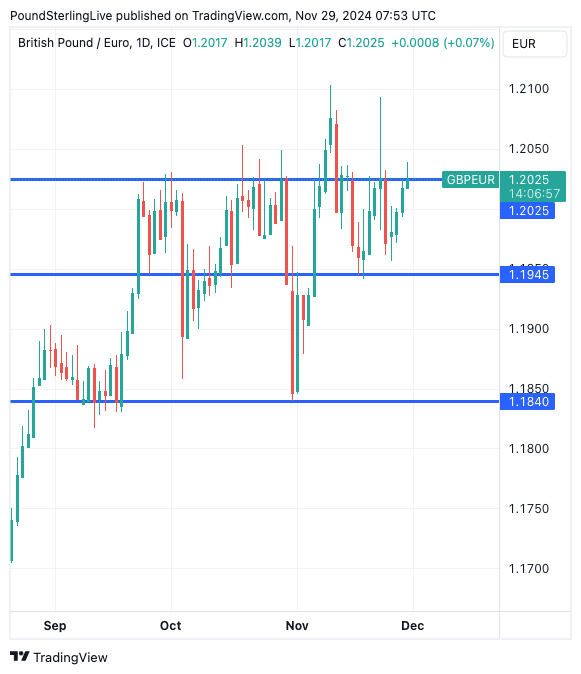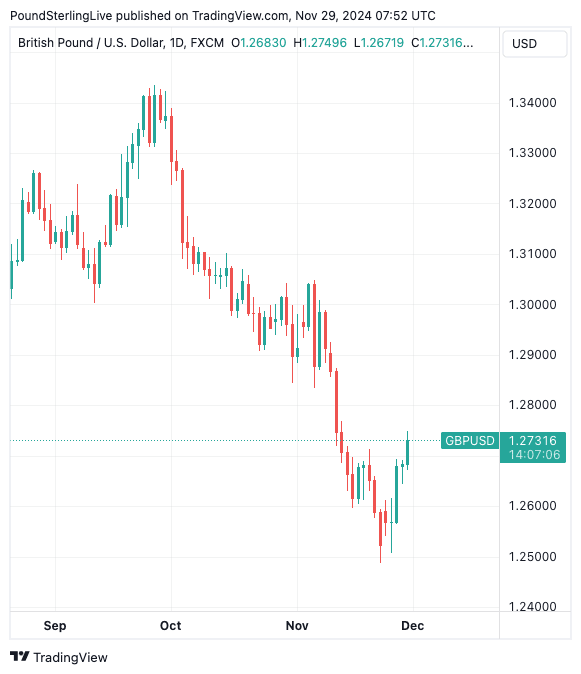Pound Sterling "Carried" Higher against Euro & Dollar
- Written by: Gary Howes
-

Image © Adobe Images
The British Pound rose against the Euro and Dollar ahead of the weekend.
The Pound to Euro exchange rate is testing the upper end of the September-November range at 1.2030, and the Pound to Dollar exchange rate has rallied to 1.2743 amidst a broadening pullback in the broader USD.
Gains for the UK currency come amidst a low volatility external backdrop that favours 'carry currencies' such as the Pound.
Volatility and liquidity have been particularly low this week. The U.S. market was off on Thursday and is unlikely to offer much today, given that markets there will only open for half a day on Friday.
The low volatility environment means the Pound can benefit from the UK's high interest rates in a trade known as the carry trade.
"Sterling is a carry currency," says James Nelligan, an analyst at JP Morgan. "Going forward, overall, it should be driven more by its yield advantage (carry) or lack thereof."
The Pound's carry advantage (or yield advantage) stems from the Bank of England's gradualist approach to cutting interest rates which leaves UK rates higher than elsewhere, particularly the Eurozone.
Above: GBP/EUR rises into resistance.
"The Pound is rising amidst a low volatility FX backdrop," says Luke Eales at SendAbroad.co.uk.
The Bank of England is expected to keep interest rates unchanged in December, whereas the European Central Bank is expected to cut rates again.
"We expect an unchanged decision in line with consensus and markets," says Kristoffer Kjær Lomholt, FX strategist at Danske Bank. "We expect the BoE to opt for a more gradual cutting cycle and deliver its next cut in February, a key argument for our bullish GBP view."
GBP/EUR investment bank consensus forecast for 2025. See the median, mean, highest and lowest point targets, giving a highly accurate forecasting resource. Request it Now.
The U.S. Federal Reserve is also expected to cut interest rates in December, leaving the Bank of England the only central bank in the trio to keep rates unchanged, burnishing Sterling's interest rate yield advantage further.
The Dollar is meanwhile staging a retreat as it corrects from overbought conditions that built up in an impressive November rally, which tends to benefit currencies that outperform in calm market conditions.
"On a broader scale, the USD rally has paused over the past week, with the broad USD on track for its first weekly decline in two months. We expect this trend to persist through year-end," says Lomholt.
Above: GBP/USD rises amidst a broader pullback in the USD.
Looking to 2025, analysts at JP Morgan think the Pound will "muddle" through, gaining ground against the Euro but losing to the Dollar.
"There are two-sided risks for Sterling in 2025, and so we think the material outperformance seen over the past few years probably won’t be repeated," says Nelligan. "Sterling should outperform euro but underperform the dollar due in part to relative tariff risk considerations."
He says the Pound should still outperform other G10 low yielders, in part due to the still solid outlook for the UK labour market, which cuts off the left tail for rate spreads.
"Overall, risks to Sterling from weaker UK growth and BoE easing are offset by relative insulation from tariff risks and still high yield, meaning Sterling likely muddles through, delivering lower returns than recent years," says Nelligan.
JP Morgan forecasts show EUR/GBP should bottom at 0.81 in the second quarter of 2025 before the Euro stages a comeback to end the year at 0.82. (This gives a GBP/EUR high at 1.23 before falling back to 1.22).
The bank's GBP/USD forecast anticipates a low of 1.21 in the first quarter of 2025 ahead of a recovery to 1.32 by year-end.












